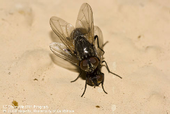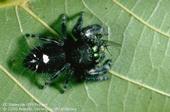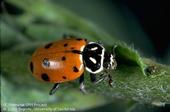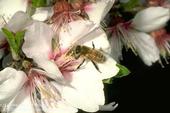- Author: Karey Windbiel-Rojas

October is a perfect time to talk about spiders! People decorate for Halloween with scary images of spiders and webs. Many people fear spiders but what you may not know is that they are helpful in our homes and landscapes.
Spiders you might find wandering in your home or hanging out in your garden are beneficial predators, eating pest insects like flies, mosquitoes, and numerous other undesirable bugs in and around landscapes.
Whether you are curious as to what kind of spider you found or you are looking for ways to get rid of them, UC IPM has the information you need in the newly revised free publication, Pest Notes: Spiders. Author...
- Author: Karey Windbiel-Rojas
- Author: Elaine Lander

We don't often find flies such a popular topic of conversation, but given recent events, we'd like to seize the moment to share some science-based information about their status as both pests and beneficial insects.
Flies can be nuisance insects both indoors and outdoors. There are many species of flies in California with some being more problematic than others. In UC IPM's publication Pest Notes: Flies, the authors provide information about identification, habitat, damage, and management of several common flies including house flies and face flies.
You may be surprised to learn that some flies are actually beneficial insects. Many flies in the...
- Author: Elaine Lander

While you are home working, learning, or relaxing, you may have noticed a few other critters sharing space with you. If some of these critters have 8 legs, we have a video to show you how to catch and release them!
Why might you release spiders outside? Spiders are beneficial insects called natural enemies. They are predators that help control other pests and insect eggs.
- Author: Elaine Lander

(Credit: Jack Kelly Clark)
Beneficial insects can provide a lot of support in the garden. Natural enemies, which include predators, parasites, and pathogens, reduce pest populations and can help prevent damage to plants. Pollinators such as honeybees, native bees, butterflies, beetles, and other insects are essential for many vegetables you may be growing.
Natural Enemies
You may not have noticed many of these parasites, pathogens, and predators that help control pests in the garden, but they are there! Lady beetles (ladybugs), lacewings, and predaceous ground beetles are some common predators that you may find in your garden...
- Author: Elaine Lander

This year, National Pollinator Week is June 22 to June 28, celebrating the value that pollinators such as bees, birds, butterflies, bats, and beetles provide to the ecosystem.
Pollinators, and natural enemies, can be harmed by pesticides when people are trying to control pests in their gardens and landscapes. Pollinators can be killed or harmed if they are sprayed or exposed directly to a pesticide, and when they encounter pesticide residues in the environment. You can protect pollinators in your garden and landscapes by doing the following:
- Use pesticides sparingly. Many pests can be managed using an integrated approach without the need to...


